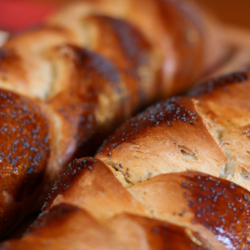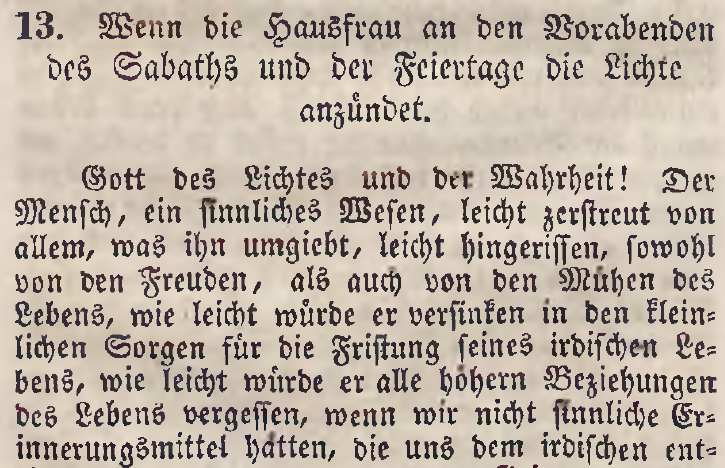| Source (Yiddish) | Translation (English) |
|---|---|
שְׁלֹשָה מִצְוֺת נִצְטַווּ הַנָשִׁים דרײַא מִצְוֺת זײנען דיא נָשִׁים גבּאָטין גיװאָרין חַנָ״ה שְׁמוֹתָן דר נאָמן פוּן די דרײַא מִצְוֺת איז חַנָ״ה דאָשׂ װאָרט חַנָ״ה מאכט חַלָה נִדָה הַדְלָקַת הַנֵר׃ |
“Women have been given three mitsvot”: Women have been given three mitsvot whose acronym is Ḥet, Nun, Hey and stands for Ḥallah, Niddah, and Hadlaqat ha-ner, which means the taking of ḥallah, observing the rules of niddah, and the kindling of light. |
בְּשַׁעַת צינדין מוּז מען מִתְפַּלֵל זײַן צו גאָט אז דיא קינדער זאָלין קענען לערען: שְׁלֹשָה מִצְוֺת אֵלֶה אִם תִּשְׁמְרוּ. דאָשׂ איז טײַטשׁ אױבּ איר װעט די דרײַ מִצְוֺת ערליך האלטין. אֲזַי קְרוֹבָה לֵידָתָן דאָשׂ איז טײַטשׁ עשׂ װעט נאָהינט זײַן אײַער גיװינען שֶׁלֹא בְּצַעַר: יָגֵן בַּעֲדָן זְכוּתָן. עשׂ װעט מַגִין זײַן דער זְכוּת פוּן די מִצְוֺת פאר אײַך: יוֹם בָּא עֵת לֵדָתָן דאָס איז טײַטשׁ אז עשׂ װעט קומען דר טאָג פוּן אײַער גיװינען: ה׳ יִשְׁמָרְכֶם מִדֶּבֶר וְאָסוֹן הַשֵׁם יִתְבָּרֵךְ װעט אײַך היטין פוּן מאָרד אוּנ אָסוֹן וְתִרְאוּ שִׂמְחָה וְשָׂשׂוֹן׃ |
“If you observe these three mitsvot,” that is, if you keep these three mitsvot faithfully, “you will give birth quickly,” that is, your lying-in will be quick and without pain. “Their merit will protect them.” The merit of these mitsvot will protect you. “When the day of their giving birth will come” means that when the day of your lying-in conies, “God will protect you from plague and disaster.”[1] Mishnah, Shabbat 2:6: “Because of three transgressions women die at childbirth: because they neglect the laws of menstrual purity, taking challah, and lighting the candles.” Hashem yitborekh (bless them) will protect you from death and disaster, that you may see happiness and joy. |
הַדְלָקַת נֵר בְּעַרְבֵי שַׁבָּתוֹת אָן צוּא צינדין דיא ליכט אױף שַׁבָּת הֵם שְׁנַיִם מִצְוֺתָן דשׂ איז טײַטשׁ עשׂ איז אײַן מִצְוָה צװײ ליכט אָן צוּא צינדין לְכָּבוֹד שַׁבָּת כְּנֶגֶד זָכוֹר וְשָׁמוֹר רְמִזָתָן. |
Lighting the candles on Erev Shabbat is a double mitsvah, which means that it is a mitsvah to light two candles in honor of the Shabbat, symbolizing the two words, “remember” and “observe.” |
די צװײ ליכט זײַנען מְרַמֵז קעגין זָכוֹר אוּנ קעגין שָׁמוֹר דאָשׂ הײשׂט אין די ערסטע עֲשֶׂרֶת הַדִבְּרוֹת שׁטײט זָכוֹר אֶת יוֹם הַשַׁבָּת לְקַדְשׁוֹ אוּנ אין דיא אנדערע עֲשֶׂרֶת הַדִבְּרוֹת שׁטײט שָׁמוֹר אֶת יוֹם השַׁבָּת לְקַדְשׁוֹ. |
The two candles indicate the two words, “remember” and “observe,” that is, in the first set of the aseret hadibrot (Decalogue) it says: “Remember the Shabbat Day to keep it holy”[2] Exodus 20:8. and in the second set it says: “Observe the Sabbath day to keep it holy.”[3] Deuteronomy 5:12. Two candles equal 500,[4] In Hebrew, letters have numerical values. “Candle” (flame) is N”R in Hebrew; nun = 50, reysh = 200. Two candles, thus equals 250 + 250. that is, equal to the limbs of a man and a woman.[5] According to tradition, men have 248 body parts and women 232. By virtue of this, Hashem yitborekh will heal the limbs of man and woman. |
נֵר נֵר תּ״ק מִסְפָּרָם דאָשׂ איז טײַטשׁ די צאָל פוּן צװײ מאָל נֵר טרעפט אָן פינף הוּנדערט קעגין אֵבָרִים שֶׁל אִישׁ וְאִשָׁה אזוֹא פיל װיא דיא אֵבָרִים פוּן דעם מאָן אוּנ פוּן דער אִשָׁה בִּזְכוּת זֶה װעט הש״י סײלין דיא גלידער פוּן אִישׁ וְאִשָׁה דרוּם אױך זאָל מען זײער ערינסט ליכט צינדין װעט הש״י דער לײַכטין דיא אױגין פוּן אײַערע קינדער אין דער הײליגער תּוֹרָה. |
Therefore, one should light the candles with serious intent and hHashem yitborekh will illumine the eyes[6] Psalms 19:9. of your children so that they will understand the holy Torah. While lighting the candles, one should pray to God that one’s children will be able to study Torah. |
דִינִים פוּן ליכט צינדין |
Rules for Lighting Candles |
אז מען צינט אָן ליכט לְכּבוֹד שַׁבָּת זאָגט מען דיא בְּרָכָה |
As one lights the candles in honor of shales, one says this blessing: |
בָּרוּךְ אַתָּה יְיָ אֱלֹהֵינוּ מֶלֶךְ הָעוֹלָם אֲשֶׁר קִדְשָׁנוּ בְּמִצְוֺתָיו וְצִוָנוּ לְהַדְלִיק נֵר שֶׁל שַׁבָּת׃ |
Blessed are you, YHVH our elo’ah Cosmic Majesty, who has hallowed us with their mitsvot and commanded us to kindle the light of Shabbat. |
לְכָּבוֹד גאָט לְכָּבוֹד אוּנזער גיבּאָט לְכָּבוֹד דעם ליבּין שַׁבָּת קוֹדֶשׁ װאָשׂ אוּנזער הער גאָט האָט אוּנז גיגעבּין דעם ליבּין שַׁבָּת קוֹדֶשׁ אוּנ האָט אוּנז גיבּאָטין דיא ליבּע מִצְוָה אז איך זאָל זיא קאָנען מְקַיֵים זײַן אוּנ זיא זאָל זײַן גיװאוֹגין אזוֹא װיא כׇּל תּרי״ג מִצְוֺת פוּן כׇּל יִשְׂרָאֵל אָמֵן כֵּן יְהִי רָצוֹן׃ |
In honor of God and in honor of our mitsvah and in honor of the precious holy Shabbat which the Lord God has given us and commanded us to observe, may I perform this mitsvah properly and may it be valued as equivalent to all of the 613 mitsvot of all Yisra’el. Amen, may it be their will. |
יְהִי רָצוֹן מִלְפָנֶיךָ יְיָ אֱלֹהֵינוּ וֵאלֹהֵי אֲבוֹתֵינוּ שֶׁיִבָּנֶה בֵּית הַמִקְדָשׁ בִּמְהֵרָה בְיָמֵינוּ וְתֵן חֶלְקֵנוּ בְּתוֹרָתֶךָ׃ וְשָׁם נַעֲבָדְךָ בְּיִרְאָה כִּימֵי עוֹלָם וּכְשָׁנִים קַדְמוֹנִיוֹת׃ וְעָרְבָה לַיְיָ מִנְחַת יְהוּדָה וִירוּשָׁלַיִם כִּימֵי עוֹלָם וּכְשָׁנִים קַדְמוֹנִיוֹת׃ |
May it be your will, YHVH, our elo’ah and the elo’ah of our ancestors, that the Beit haMiqdash be rebuilt speedily in our days, and grant us a portion in your Torah. There we shall worship you in awe as in the days of old and in ancient rimes. And may the offering of Yehudah and Yerushalayim be as pleasant to YHVH as in days of old and in ancient times.[7] Malachi 3:4. [8] From the prayer following Elohai Netsor, after the Amidah. |
רבש״ע מײן מִצְוָה פוּן דיא ליכט אָן צינדין זאָל אזוֹא אָן גינוּמען זײַן װיא דיא מִצְוָה פוּן דעם כֹּהֵן גָדוֹל װען ער האָט די ליכט אין ליבּין בּ״ה אָן גיצוּנדין איז זײַן מִצְוָה אָן גינוּמען גיװאָרין אזוֹ זאָל מײַן מִצְוָה אױך אָן גינוּמען װערין נֵר לְרַגְלִי דְבָרֶךָ וְאוֹר לִנְתִיבָתִי דאָשׂ איז טײַטשׁ דײַנע רײַד איז אײַן ליכט צוּא מײַני פיס אוּנ מײַנע קינדער זאָלין גײן אין גאָטש װעג אוּנ דיא מִצְוָה פוּן מײַנע ליכט צינדין זאָל אָן גינוּמען װערין אז מײַנע קינדרשׁ אױגין זאָלן לײַכטן אין דער ליבּער הײליגער תּוֹרָה אױך טוא איך בּעטין בּײַ די ליכט דעם ליבּין גאָט בּ״ה אז מײַן מִצְוָה פוּן די ליכט זאָל אָן גינוּמען װערין װיא דאָשׂ ליכט האָט גיבּרענט פוּן דעם בּױם אײַל אין בּה״מ אוּנ איז ניט פאר לאָשׁין גיװאָרין. |
Ribono shel Olam, may the mitsvah of my lighting the candles be accepted as equivalent to the mitsvah of the Kohen Gadol when he lit the candles in the precious Beit haMiqdash. As his observance was accepted, so may mine be accepted. “Your words are a candle at my feet and a light for my path”[9] Cf. Psalms 119:105. means that your words are a candle at my feet so that all my children may walk in God’s path, and may the mitsvah of my candlelighting be accepted so that my children’s eyes may be illumined by the precious holy Torah. I also ask at this time that this mitsvah of lighting candles be accepted as equivalent to the olive oil which burned in the Beit haMiqdash and which was never extinguished.[10] Exodus 27:20 and Leviticus 24:2. |
בִּזְכוּת דאָשׂ ליכט פוּן דעם ליבּין שַׁבָּת זאָל מַגִין זײַן װיא דר ליבער שַׁבָּת האָט מַגִין גיװען אױף אָדָם הָרִאשׁוֹן װי ער איז בַּהיט גיװאָרין פר אײַן גיכין טױט אזוֹ זאָל אוּנזר זְכוּת פוּן די ליכט מַגִין זײַן אז אוּנזרי קינדרשׂ ליכט זאָל לײַכטין אין דר תּוֹרָה זײערי מַזָלוֹת זאָל לײכטן אין הימיל זײ זאָלין קענען פַּרְנָסָה געבּין צו װײַבּ אוּנ קינדר בְּעַיִן יָפֶה |
May the merit of the beloved Shabbat lights protect me, just as the beloved Shabbat protected Primæval Adam[11] Louis Ginzberg, Legends of the Jews vol. I (Philadelphia, 1954), 85-86. and kept him from premature death. So may we merit, by lighting the candles, to protect our children, that they may be enlightened by the study of Torah, and may their planets shine in the heavens so that they may be able to earn a decent living for their wives and children, under an approving gaze. |
אוּנ אוּנזרי מִצְוֺת זאָלין אָן גינוּמן װערן װי די מִצְוֺת פוּן אוּנזרי אָבוֹת וְאִמָהוֹת אוּנ די שְׁבָטִים הַקְדוֹשִׁים מיר זאָלן זײַן אזוֹא רײַן װיא אײַן קינד װערט גיבּאָרין פוּן זײַן מוּטער אָמֵן׃ |
May our mitsvot be accepted as equivalent to the mitsvot of our patriarchs and matriarchs and of the holy tribes so that we may be as pure as a child newly born of its mother. Amen. |
This is the tkhine for the mitsvot of kindling the Shabbat lights as found in Sarah bat Tovim’s Tkhine of Three Gates, likely written by her sometime in the early 18th century. The transcription was drawn from that of Rabbi Tracy Klirs published with her HUC dissertation and subsequently published by HUC Press in In the Merit of Our Mothers (1991). I have made some changes to the translation, re-Hebraizing loshen qodesh and biblical names, and presenting Hashem as gender-neutral. The text concerning candle lighting is preceded by some general text and is interspersed with some text concerning ḥallah and niddah. I have joined together both of the sections concerning candle lighting. Where I have found any short gap in the translation or a missing reference, I have added it. –Aharon Varady
Source(s)

Notes
| 1 | Mishnah, Shabbat 2:6: “Because of three transgressions women die at childbirth: because they neglect the laws of menstrual purity, taking challah, and lighting the candles.” |
|---|---|
| 2 | Exodus 20:8. |
| 3 | Deuteronomy 5:12. |
| 4 | In Hebrew, letters have numerical values. “Candle” (flame) is N”R in Hebrew; nun = 50, reysh = 200. Two candles, thus equals 250 + 250. |
| 5 | According to tradition, men have 248 body parts and women 232. |
| 6 | Psalms 19:9. |
| 7 | Malachi 3:4. |
| 8 | From the prayer following Elohai Netsor, after the Amidah. |
| 9 | Cf. Psalms 119:105. |
| 10 | Exodus 27:20 and Leviticus 24:2. |
| 11 | Louis Ginzberg, Legends of the Jews vol. I (Philadelphia, 1954), 85-86. |

“תְחִינָה פון דיא מִצְוה הַדְלָקַת הַנֵר | Prayer for the Mitsvah of Kindling the Shabbat Lights, by Sarah bat Tovim from the Tkhine of Three Gates (ca. early 18th c.)” is shared through the Open Siddur Project with a Creative Commons Attribution-ShareAlike 4.0 International copyleft license.










Leave a Reply